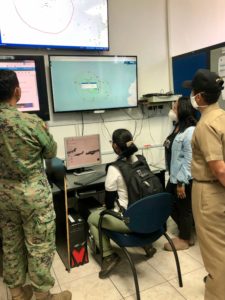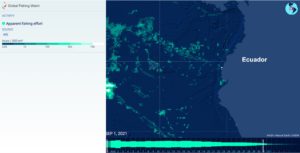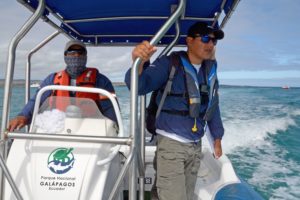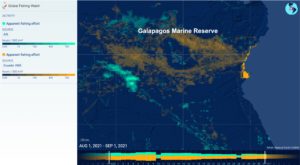Ecuador Shares Location of Domestic Fishing Fleet to Improve Transparency, Combat Illegal Fishing and Better Protect Iconic Wildlife
October 29, 2021; By WildAid Marine
The Ecuadorian government demonstrated leadership and their commitment to stopping illegal, unreported and unregulated (IUU) fishing by publicly sharing data about where their fishing vessels operate. This is the country’s latest effort to enhance surveillance and technological capabilities; to bolster fisheries monitoring and control of Ecuadorian waters including around the Galapagos Islands.
Located 1,000 km (600 miles) off the coast of continental Ecuador, the Galapagos Islands are a treasured natural wonder of the world, home to nearly 3,000 marine species, of which approximately 20 percent are found nowhere else on earth. Spectacular marine wildlife resides there, including many species of whales, sea turtles, giant manta rays, penguins and 34 types of sharks, such as the endangered scalloped hammerhead.
The Galapagos Islands were among the first sites chosen by UNESCO’s World Heritage Program as a critical and irreplaceable source of life, inspiration and outstanding universal value and have been protected as a marine reserve since 1998. The Galapagos Marine Reserve (GMR) is now one of the best enforced reserves in the developing world and its’ systems can provide a model for other countries struggling to protect their oceans.
Over the last 20 years, WildAid Marine has worked with the Ecuadorian government to improve marine enforcement of the 133,000 square km (51,000 mi2) GMR. In 2010, WildAid Marine helped Ecuador acquire satellite vessel monitoring systems (VMS) and automatic identification systems (AIS) to remotely monitor vessels sailing in and around the GMR, as well as procure equipment and patrol boats to increase ranger’s capacity to get on the water and respond to illegal activities and other threats to endangered species.
These efforts have made the GMR a regional leader in effective enforcement, and a successful example of WildAid Marine’s BLUEPRINT for Marine Protected Area Success™ , a six-step process to achieve meaningful protection and sustainable conservation outcomes, in partnership with Ecuador.

Command central for the Galapagos National Park Directorate and remote tracking of vessel movement near the GMR.
With this technology and WildAid’s comprehensive Marine Protection System (MPS) on board, Ecuador signed an MOU with Global Fishing Watch (GFW) in 2020 to make their VMS tracking data publicly visible on the GFW map platform. VMS fishing vessel data is typically not shared with the public and other countries but with this decision, supported by the Ministry of Defense, Ecuador took a major step forward as a key ally of ocean transparency in the eastern Pacific.
 Global Fishing Watch’s map illustrates the difference between when Ecuador’s VMS data is turned on (top) versus off (bottom) and compliance with GMR restrictions.
Global Fishing Watch’s map illustrates the difference between when Ecuador’s VMS data is turned on (top) versus off (bottom) and compliance with GMR restrictions.
Today, over 700 Ecuadorian vessels have VMS and are now visible and can be tracked on the GFW platform. It is clear from recent data that the Ecuadorian industrial fishing fleet respect the boundaries of the GMR and associated regulations designed to protect the area.
GFW’s map is the first open-access online platform for visualization and analysis of vessel-based human activity at sea. Powered by satellite technology and machine learning, the map merges multiple types of vessel tracking data to provide a view of global human activity at sea, including fishing activity, encounters between vessels, night light vessel detection and vessel presence.
GFW also provides Ecuador with activity reports of the distant water squid fleet operating in the Southeast Pacific. These activities underline the value of the WildAid supported VMS/AIS in creating a clearer picture of what is happening in the region’s waters. Moreover, availability of these data put the fleets on the general public’s ‘radar’ and raises global awareness into the presence and activities of other industrial fishing fleets on the high seas.
Despite their promise, marine protected areas (MPAs) struggle to achieve success due to a common problem –the lack of effective enforcement. Less than 3% of the world’s oceans have some level of protection, and 60% of MPAs are not well-regulated or enforced. MPAs with strong enforcement capacity perform almost 3 times better than those without.
Real protection, like the Galapagos Islands enjoy, requires comprehensive surveillance, monitoring and enforcement, strong policies and consequences for illegal activity, sustainable financing, and effective collaboration between governments, communities, and nonprofits.
Ecuador has emerged as a regional leader to share the success of WildAid’s replicable and scalable MPS plans with other Latin American countries. Through these impactful partnerships, Ecuador continues to improve its analytical capabilities and harness cutting-edge technology for enhanced fisheries monitoring of its national and surrounding waters. This also applies to the management and enforcement of 19 MPAs located along coastal Ecuador and is one step closer to achieving the IUCN goal of protecting 30% of the ocean by 2030 to help safeguard the health and biodiversity of the world’s oceans.

Two Galapagos National Park rangers patrolling the GMR.
